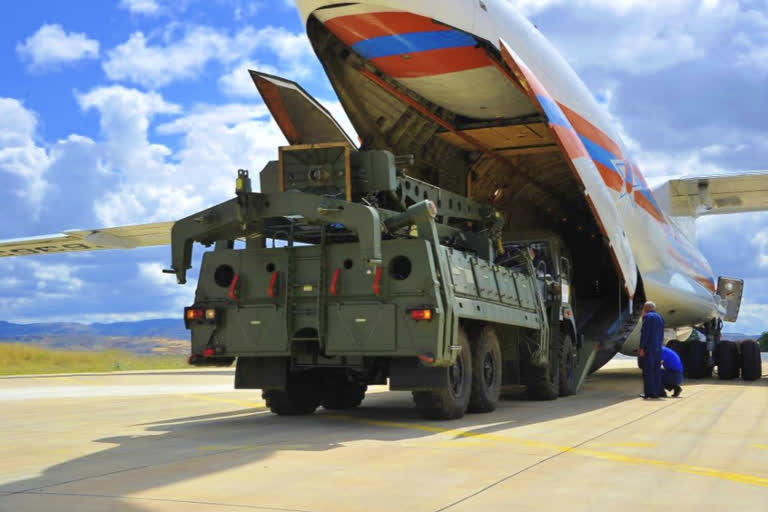NEW DELHI: It’s a classic “heads you win, tails I lose” situation for the US that it is finding difficult to wriggle out from.
Faced with a difficult situation on the issue of imposing sanctions on India under the stringent provisions of the Countering America’s Adversaries Through Sanctions Act (CAATSA) for buying the S-400 ‘Triumf’ air defence system from Russia, the US may resort to face-saving measures so as not to alienate India in toto and yet maintain ‘some’ sanctity of its laws.
On Monday, Pentagon Press Secretary John F. Kirby indicated the unease at a briefing when he responded to a pointed query from a reporter: “I think we've been very clear with our Indian partners about our concern over this system (S-400). I don't have any updates to say. I mean, you -- when the Secretary visited the New Delhi again, we talked about this then. I mean, these -- we certainly have concerns over that system, but I don't have any updates for you.”
Meanwhile, an unperturbed Russia went ahead with its contractual. On Monday, the chief of the Russian state-owned arms seller Rosoboronexport Alexander Mikheyev said at the Dubai Airshow 2021: “The equipment shipment (to India) has begun ahead of schedule...The Indian specialists who will operate the first regiment set have completed their training and returned home…All the material of the first regiment set will be delivered to India at the end of 2021. Immediately after the New Year, our specialists will arrive in India for the equipment transfer at the sites where it will be stationed.”
But there are several factors that US will be assessing including to what extent it would go to impose CAATSA, a 2017 US federal legislation that imposed sanctions on Russia, Iran, and North Korea and seeks to apply sanctions on anyone dealing with them.
One, if the CAATSA sanctions are waived for India, it would give big offence to key NATO ally Turkey as US did not make an exception for Turkey buying the same air defence system from Russia.
Further distancing from Turkey at a time when Turkish influence is spreading and getting bigger in Afghanistan, Central Asia and the Balkans may not be very appropriate for the US at this point of time. Among other things, it will push Turkey into Russia’s open arms.
Two, the US realizes that Russian weapon imports to India will definitely not stop with the S-400. And stringent sanctions on India will open the floodgates of Russian platforms like Russian-made submarines and stealth fighter aircraft for the Indian military. And also for other military majors like France and Israel.
Recently, India’s outgoing ambassador to Russia, Bala Venkatesh Varma had pointed out that Russia's defence contracts with India had gone up to about 9-10 billion dollars in 2021 from about 2-3 billion dollars in 2018.
Three, if the sanctions on India fail to produce the desired results, there will be gross undermining of US’ prestige and power projection among the comity of nations of the world, something that is also on the ebb with the chaotic withdrawal from Afghanistan still fresh in memory.
Four, the US would be duly alarmed with the prospect of India integrating the S-400 system with the US systems that India has been given access to after inking the last of the foundational military pacts with the US called the BECA (Basic Exchange and Cooperation Agreement).
BECA gives India access to the much advanced and accurate US geo-spatial data including digital imagery and maps besides being the first step for India to acquire the armed UAVs and killer drones. Access to the US geospatial data is a must for these UAVs to effectively operate.
But integrating the S-400 with the US systems may give rise to issues including illegal transfer of intellectual property.
Five, from the Indian perspective the issue is whether India would be able to sustain the impact of sanctions by the US particularly at a time when the Indian economy is on the recovery mode.
According to Prof Kumar Sanjay Singh, a strategic analyst who teaches history at a Delhi University college, “it will ultimately boil down to what extent the US would restrain or withhold the imposition of the CAATSA on India. But the space for the US to maneuver on the issue seems constrained at the moment. Therefore, while the likelihood of imposition of CAATSA is strong, it may be in a more symbolic manner than in a substantial way.”
As for greater strategic positions relating to a rising China and warming India-US bilateral ties, the US will try to ensure that the Indian economy is not impacted beyond a certain point but at the same time no future purchases of military equipment takes place from Russia by India.
Meanwhile, three US senators have sought relaxations of CAATSA stipulations under a legislation called the Circumspectly Reducing Unintended Consequences 15 Impairing Alliances and Leadership (CRUCIAL) Act of 2021, which if approved, will allow India to execute defence deals with Russia for the next 10 years without any threat of US sanctions.
That is why the US, while not shying down from imposing the CAATSA sanctions, will yet try to lighten the onerous burden on India. Pussyfooting may be the new US strategy to deal with India.
Also read: US expresses 'concern' over delivery of Russia's S-400 missile system to India



